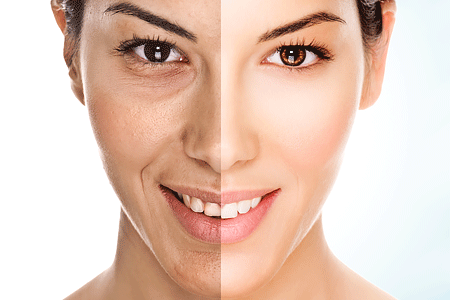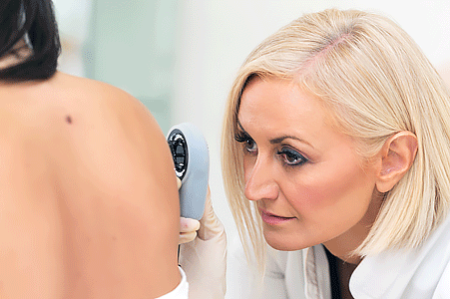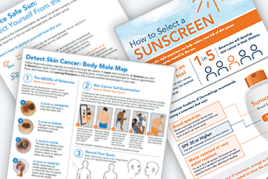10 surprising facts about indoor tanning
Is a tanning bed really safer than the sun? Will indoor tanning help your body make all of the vitamin D it needs? Findings from years of scientific studies have answered these and other burning questions about indoor tanning.
Here are 10 research-backed facts that may surprise you.
Tanning beds are NOT safer than the sun. Science tells us that there’s no such thing as a safe tanning bed, tanning booth, or sun lamp. Indoor tanning can increase the risk of developing the two most common types of skin cancer — squamous cell carcinoma by 58% and basal cell carcinoma by 24%.1 Using tanning beds before age 20 can increase your chances of developing melanoma by 47%, and the risk increases with each use.2
Fact: A sunburn can cause more than discomfort
Research shows it only takes one blistering sunburn during childhood or adolescence to nearly double a person's risk of developing melanoma, the deadliest form of skin cancer, later in life.
Source: AAD news release3

Tanning — indoors or with the sun — makes your skin age more quickly. Wrinkles, age spots, and loss of skin firmness tend to appear years earlier in people who tan. Anyone who tans can also develop leathery skin, which people who never tan don’t get.
Fact: Tanning indoors makes your skin age more quickly
Indoor tanning (left side) dramatically speeds up how quickly your skin ages.

Using tanning beds can cause a serious injury. In emergency rooms across the United States, people are treated for burns, loss of consciousness, and eye injuries caused by indoor tanning.
Getting a base tan cannot prevent sunburn. Many people believe that using a tanning bed to get a base tan will prevent sunburn. Absolute myth. If you have a base tan, you can still burn.
Fact: By choosing not to tan, you reduce your risk of getting skin cancer
Using tanning beds before age 20 can increase your chances of developing melanoma by 47%, and the risk increases with each use.4

Getting enough vitamin D from tanning beds isn’t possible. You may have heard that your body makes a lot of vitamin D when you use a tanning bed. It doesn’t. The bulbs used in tanning beds emit mostly UVA light; however, your body needs UVB light to make vitamin D.
Becoming addicted to tanning is a real risk. Evidence indicates that tanning can be addictive. Some people find it hard to stop tanning. When they don’t get a steady dose of UV rays, they feel fidgety or depressed.
Tanning (indoors or outside) can make stretch marks more noticeable. The best way to hide stretch marks is with a self-tanner.
Giving customers “false and misleading information” has been a common practice at tanning salons. A study run by the U.S. House of Representatives’ Committee on Energy and Commerce made a startling discovery.
Looking tan year-round is possible with a self-tanner. Many people say they use tanning beds because they like the way a tan makes them look. A self-tanner offers you a way to look tan without increasing your risk of developing early wrinkles, leathery skin, and skin cancer.
Quitting (or never starting) indoor tanning can help you live longer. By choosing not to tan, you reduce your risk of getting many types of skin cancer, including melanoma. You also reduce your risk of developing pre-cancerous skin growths called actinic keratoses (AKs). It is estimated that more than 40 million Americans develop AKs each year.8
It’s never too late to start protecting your skin from the sun and indoor tanning beds. As soon as you do, your body starts to repair some of the damage caused by the UV rays. And that’s a fact.
1,2,4American Academy of Dermatology. Indoor tanning fact sheet. Last accessed June 23, 2022.
3American Academy of Dermatology. ”New survey reveals public confusion about risks of tanning and sunburns.” News release issued May 24, 2022. Last accessed June 23, 2022.
5,6,7U.S. House of Representatives Committee on Energy and Commerce. “False and misleading health information provided to teens by the indoor tanning industry.” Published February 1, 2012. Last accessed April 11, 2018.
8Lim HW, MD, Collins SAB, et al. “The burden of skin disease in the United States.” J Am Acad Dermatol 2017;76:958-72.
Images
References
Indoor tanning fact sheet
New survey reveals public confusion about risks of indoor tanning and sunburns (May 2022)
Banerjee SC, Hay JL, et al. “Quitting the ‘cancer tube’: A qualitative examination of the process of indoor tanning cessation.” Transl Behav Med. 2014; 4(2): 209-19.
Coups EJ, Stapleton JL, et al. “Frequent indoor tanning among New Jersey high school students.” J Am Acad Dermatol. 2015; 72(5): 914-16.
Ernst A, Grimm A, et al. “Tanning lamps: Health effects and reclassification.” J Am Acad Dermatol 2015;72:175-80.
Guy GP Jr, Berkowitz Z, et al. “Indoor tanning among high school students in the United States, 2009 and 2011.” JAMA Dermatol. 2014; 150(5):501-11.
Lim HW, MD, Collins SAB, et al. “The burden of skin disease in the United States.” J Am Acad Dermatol 2017;76:958-72.
Stier MF and Hirsch RJ. “Rejuvenation of scars and striae.” In: Hirsch RJ, et al. Aesthetic rejuvenation. McGraw Hill Medical, China, 2009:224-9.
U.S. House of Representatives Committee on Energy and Commerce. “False and misleading health information provided to teens by the indoor tanning industry.” Published February 1, 2012. Last accessed June 23, 2022.
Last updated: 4/26/23
 Atopic dermatitis: More FDA-approved treatments
Atopic dermatitis: More FDA-approved treatments
 Biosimilars: 14 FAQs
Biosimilars: 14 FAQs
 How to trim your nails
How to trim your nails
 Relieve uncontrollably itchy skin
Relieve uncontrollably itchy skin
 Fade dark spots
Fade dark spots
 Untreatable razor bumps or acne?
Untreatable razor bumps or acne?
 Tattoo removal
Tattoo removal
 Scar treatment
Scar treatment
 Free materials to help raise skin cancer awareness
Free materials to help raise skin cancer awareness
 Dermatologist-approved lesson plans, activities you can use
Dermatologist-approved lesson plans, activities you can use
 Find a Dermatologist
Find a Dermatologist
 What is a dermatologist?
What is a dermatologist?


